MODIFICATION OF A HIGH-SPEED CUTTING TOOL SURFACE BY COMBINED TUNGSTEN STEEL AND NITROGEN SATURATION
- Authors: Larisa G. P.G.1, Sergeeva A.S.2, Vdovin V.M.3,2
-
Affiliations:
- Moscow Automobile and Road Engineering State Technical University (MADI)
- The Moscow State Technical University - MADI
- PC Lavochkin SPC
- Issue: No 7 (145) (2023)
- Pages: 24-32
- Section: Technologies of electromachining and combined processing
- URL: https://bakhtiniada.ru/2223-4608/article/view/350091
- DOI: https://doi.org/10.30987/2223-4608-2023-7-24-32
- ID: 350091
Cite item
Full Text
Abstract
Research significance is contingent on the requirement strengthening for high-speed cutting tools performance and wide-spread introduction of automatic lines and NC-machines. An increase of the tool service life is also necessary for the reduc-tion of putting expensive alloying elements to use, primarily, tungsten. The solution of these problems requires the use of technologies for hardening cutting surfaces. Combined processes of thermochemical treatment processes, uniting diffusive surface alloying with nitrogen saturation have shown their effectiveness in the surface hardening of various steels. Now the aim is to study the process of combined surface tungsten and nitrogen saturation of high-speed steel for increasing small-sized tool durability. Experimental studies were carried out on samples and small-diameter drills made of P6M5 steel. For laboratory experiments connected with combined process of thermochemical treatment an installation for nitriding in multi-component media was used. Metallization with tungsten was carried out by the slip method with parallel nitriding of the tool in a glow discharge. To determine the regime that provides the necessary temperatures for oxygen and nitrogen saturation, the temperatures of the control steel samples were measured on the surface and in the core at different durations of the cur-rent pulse in the heating phase. Metallographic analysis proved that thermochemical treatment resulted in a modified sur-face layer with a thickness of 10…15 microns, formed in P6M5 steel. The structure of the layer is an internal nitriding zone, which consists of a solid tungsten and nitrogen solution in iron and dispersed inclusions of tungsten nitrides. Dispersion and solid solution hardening provide a two-fold increase in the microhardness of the modified W-N layer compared to the alloy base. A transitional diffusion zone of nitrogenous martensite has been revealed under the hardened layer, creating a smooth microhardness gradient from the layer to the core, protecting it from embrittlement, peeling and staining. Using a metallophysical simulated test in predeveloped methodology, the calculation of the hardening index of the modified layer (yield point increase) was made. It showed that with increase in the concentration of tungsten in the layer, the proportion of the component of the dispersion hardening by W2N particles also increases. Full-scale tests in production conditions showed that the tool with a hardened layer had increased resistance. The durability of drills, determined by the number of drilled holes made before its dropping-out, increases by 2,2 times when drilling on 30XGSA steel and by more than 7,0 times when drilling a titanium alloy VT-23.
Keywords
About the authors
Petrova Georgievna Larisa G.
Moscow Automobile and Road Engineering State Technical University (MADI)
Author for correspondence.
Email: petrova_madi@mail.ru
ORCID iD: 0000-0002-7248-2454
SPIN-code: 5452-2754
Scopus Author ID: 7102799952
Department of Construction Materials Engineering, doctor of technical sciences
Alexandra Sergeevna Sergeeva
The Moscow State Technical University - MADI
Email: sergeevamadi@yandex.ru
Viktor Maksimovich Vdovin
PC Lavochkin SPC; The Moscow State Technical University - MADI
Email: vdovin-viktor@bk.ru
References
Адаскин А.М. Быстрорежущие стали нового поколения / А.М. Адаскин, Л.С. Кремнев, И.Ю. Сапро-нов // Перспективные материалы. 2014. № 2. С. 48-54. EDN: RVOJOT Григорьев С.Н., Черкасов П.М., Сгибнев Р.В. Технологические особенности вакуумно-плазменной обработки осевого мелкоразмерного инструмента // Материалы Всероссийской научно-практической кон-ференции и выставки «Технологии и оборудование для нанесения износостойких, твердых и коррозионностой-ких покрытий». Москва: РХТУ, 2004. С. 54-55. Полетаев В.А. Упрочнение сверл из быстроре-жущей стали импульсной магнитной обработкой // Novainfo.ru. 2017. Т. 1. № 73. С. 43-47. EDN: ZSGKUP Александров В.А. Азотирование инструмента из высокохромистых и быстрорежущих сталей / В.А. Александров, К.В. Богданов // Упрочняющие техноло-гии и покрытия. 2005. № 5. С. 14-20. EDN: REVHVZ Петрова Л.Г., Александров В.А., Вдовин В.М., Демин П.Е. Повышение стойкости инструмента из быстрорежущей стали при азотировании с регулируе-мым азотным потенциалом // Наукоемкие технологии в машиностроении. 2022. № 1 (127). С. 3-10. doi: 10.30987/2223-4608-2022-1-3-10. EDN: SIEEWS Belashova I. S., Petrova L. G., Aleksandrov V. D., Demin P. E. Improving the Properties of Low-Alloy and Carbon Steel Tools by Cyclic Nitriding // Russian Engineer-ing Research. 2018. Vol. 38, No. 1. P. 53-56. doi: 10.3103/S1068798X18010057 EDN: UXTIEA Малахов А.Ю., Александров В. А., Перекрестова В. А. Комбинирование процессов метал-лизации и низкотемпературного азотирования // Тен-денции развития науки и образования. 2019. № 46-7. С. 36-43. doi: 10.18411/lj-01-2019-130. EDN: ZTAHFZ Александров В.А., Петрова Л.Г., Сергеева А.С. [и др.]. Повышение стойкости режущего инструмента методом модифицирования поверхности с нанесением покрытий из соединений вольфрама в высокочастотном разряде // Упрочняющие технологии и покрытия. 2018. Т. 14. № 1(157). С. 30-35. EDN: YMILGO Демин П. Е., Барабанов С. И., Малахов А. Ю., Александров В. А. Упрочнение штамповых сталей ме-таллокерамическими покрытиями, получаемыми спо-собом газового азотирования // Наукоемкие техноло-гии в машиностроении. 2022. № 2 (128). С. 17-21. doi: 10.30987/2223-4608-2022-2-17-21. EDN: LRZELI Petrova L.G., Demin P.E. Surface modification techniques for steel components working in wear and cor-rosion conditions/ Key Engineering Materials. 2022. Т. 909 KEM. С. 108-114. Петрова Л.Г. Оценка прогнозируемого упроч-нения железа при поверхностном легировании метал-лом в сочетании с азотированием // Технология метал-лов. 2022. № 8. С. 41-52. doi: 10.31044/1684-2499-2022-0-8-41-52. EDN: QRNGSX Aleksandrov V.A., Petrova L.G., Sergeeva A.S., Aleksandrov V.D., Akhmetzhanova E.U. Production of tool coatings by chemicothermal plasma methods // Rus-sian Engineering Research. 2019. Т. 39. № 8. С. 693-695. doi: 10.3103/S1068798X19080033 EDN: JXHQZQ
Supplementary files









